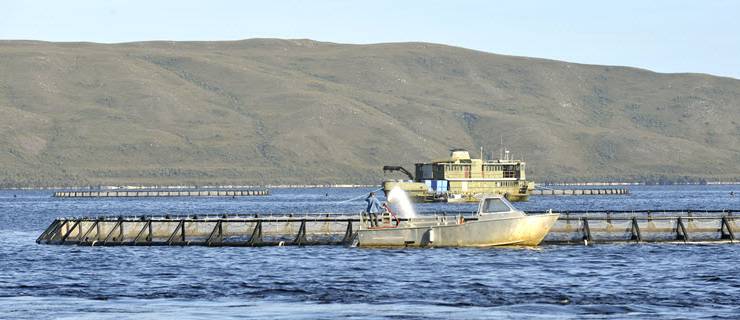
All fish stink. Some stink more than others. When it comes to salmon company Tassal, there is a growing band of critics who think the odour is getting worse.
Like its big Tasmanian predecessor Gunns, Tassal is an unusual company because it has an open share register but has been led by the same chairman and CEO for more than a decade. Chairman Allan McCallum lives in Victoria but has been a Tassal director since 2003 and chairman since 2005. Managing director Mark Ryan was a PwC restructuring expert who decided to make his career building Tassal, that is now capitalised at $710 million. He’s been CEO since 2003 and a director since 2005.
Both men like to go hard and it’s fair to say they are fairly entrenched in their positions – and keen to stare down “the greenies” in their pursuit of rapid growth.
Since Four Corners first aired concerns regarding the environmental management of Macquarie Harbour last year, the smell around Tassal has only continued to grow and it has showed little sign of going away.
The company is pushing ahead with a controversial expansion into Okehampton Bay on Tasmania’s east coast — despite failing to secure a social licence, scientific concerns the area is unsuitable for salmon farming and proceedings in the Federal Court by activists attempting to overturn Commonwealth approvals of Tassal’s operations.
This comes on top of two existing actions its competitor Huon Aquaculture has commenced in the Federal and Supreme Courts against Tassal, the Tasmanian and Commonwealth governments in regard to the alleged mismanagement of Macquarie Harbour.
Tassal also had the somewhat dubious honour of being the first ASX listed company to be referred to the powerful Senate Privileges Committee over issues related to influencing witnesses at a 2015 Senate inquiry. The company was chastised for negotiating a purchase agreement with a witness who was slated to give evidence against Tassal – the witness alleges they were paid “hush money”.
Consumers are rebelling too with domestic prices sliding 20% across the past year following revelations that the company uses a synthetic dye (astaxanthin) in its fish feed in order to ensure the salmon’s flesh has its distinct bright coral hue, the absence of which would see the salmon flesh more closely resemble the grey water from your washing machine.
Tassal also recently admitted its use of antibiotics has soared 75% in the past year, hardly consistent with leveraging the Tasmanian brand and leaving Tassal open to attack in a markets campaign. Interestingly, its competitors actually reduced their use of antibiotics across the same period. Throw in a stagnating share price relative to the market and investors are rightly concerned that the company is potentially heading into a perfect storm of its own creation.
When you strip away the rhetoric on both sides of the debate on salmon farming, investors are left with some inconvenient truths: much of the company’s present problems, both on water and in the board room, are being driven by a lack of understanding of the impacts of climate change.
If CSIRO modelling is to be believed, Tasmania’s coastal and estuarine environment is warming at a rate that will see it commercially unviable to farm Atlantic Salmon within the decade. The optimum temperature for adult salmon grow out is 10-15 degrees Celsius, Tasmania’s coastline is now frequently experiencing sea surface temperature spikes into the mid-20s. This inhibits salmon growth, increases the prevalence of the amoebic gill disease, that in turn drives up antibiotic use.
Tassal states in its annual report that it plans 15 years ahead; mitigation of climate change impacts on the business should be front of mind. Investors shouldn’t be fooled by spin claiming that average temperatures are still within acceptable limits – salmon don’t care for statistics, if it’s too hot they just die.
Tassal’s 2017 report still seeks to maintain the impression its operations have been impacted by “unforeseen environmental non-compliances”. The reality is these “non-compliances” are being driven by climate change and represent the new normal for their operating environment.
More worrying is that Tassal self-insures its live fish, meaning that mass fish mortalities are under-written by shareholders, yet the company continues to fail to identify and address climate change as a material business risk in accordance with a recent APRA directive. It’s most recent annual report makes only passing mention of what Tassal is doing to combat climate change impacts on the environment.
Rival Huon Aquaculture has spent $200 million on developing new technology in order to move its salmon offshore into deeper and colder water, while heeding some environmentalists’ and consumers’ concerns. But Tassal argues it can selectively breed salmon capable of surviving in higher temperatures. Given Tasmania still zealously guards its GMO-free status, this approach is problematic.
All of this will make for a most interesting annual general meeting debate in Melbourne tomorrow, Wednesday October 25. Proceedings kicks off at 2pm at the Stamford Hotel.
*Stephen Mayne is a small shareholder in Tassal and will be asking questions at tomorrow’s AGM as an individual investor, not a director of the Australian Shareholders’ Association.








Huon has also announced an onshore salmon nursery a Port Huon which would see smolt grown on land to 500-600g before being transferred to sea pens. Apparently its aim is to reduce the time salmon spend at sea to within 12 months. Better for the environment, better for risk reduction.
Norway has Salmon farming in its pristine Fjords. But like all its fishing activities it is sustainable .
For instance the cod industry has been one of the mainstay of the economy since the middle ages [yes hundreds of years] and it continues to thrive – in contrast to Canada & USA where there used to be a cod industry, by completely clearing out the cod in relatively short time there is fishing industry.
The reason why there is viable salmon farming is the the Norwegians understand the problems and manage to avoid them . Just good management. The Salmon farms have a time limit on the location then must move and not return for a specified period. Thus the Fjords are kept pristine. This is simple agricultural principle of crop rotation and letting the soil lie fallowto recover. Unfortunately Tasmania – or Australian corporate culture does not appear to understand natures spreadsheet only an accounting spreadsheet. So Tasmania as usual will soil its environment then whinge they haven’t any industry.
oops ! end of first para should be – there is no cod fishing industry.
Aldi sells the Norwegian smoked salmon it’s not only more environmentally ethical but it tastes better. Bonus!
Since the Four Corners’ expose this household has banned all Tassal product & takes every opportunity to badmouth them. The ABC should air the programme again.
I agree. I personally feel that Tassal salmon is grown in waters that are now so polluted, the fish are so full of antibiotics and God knows what other chemicals that I have banned it also. This is a company that is so greedy that they have forgotten quality of their product.
What colour are these Norwegian salmon?
Would they be pink / red from the astaxanthin they use? http://network.bellona.org/content/uploads/sites/3/2015/06/ingressimage_11272103_EFF-1.-2.1.jpg
Tassal are a bunch of vandals as far as I can see. Salmone farming is an absurd industry in most regards, especiallyas they do it. MacQuarie Harbour is an example of the attitude of business to the environment.
Tassal’s woes are without a doubt much of its own making but of course not entirely – life is never that simple. Tassal’s recent proposal discharge treated waste water near the mouth of Macquarie Harbour was particularly naive from a PR point of view. Just a few questions Stephen Mayne might add to his AGM list. Was 4 Corner’s concern re “the environmental management of Macquarie Harbour” as much about negligence on the part of the EPA as it was about farmers pushing the limits (without proper supervision)? Who are the other players in the Okehampton Bay controversy and what is the overall context for this? Does the Okehampton Bay development have any support, if so from whom? How is Huon Aquaculture’s court action going? Who referred Tassal to the Senate Privileges Committee? Is astaxanthin (the most common carotenoid in the wild salmon’s diet) used in Norway or other countries, and if so why? What is the difference between a “synthetic” substance and the same naturally occurring substance? Is it true that Tassals’s “‘2017 class’ of salmon has been vaccinated and it doesn’t expect to use any antibiotics” in line with Petuna’s practice? Is Huon vaccinating its fish, if not, why not? What is the difference between selective breeding and genetic engineering? What is Petuna “doing to combat climate change impacts on the environment”? Sorry for the ignorance, just curious about the answers.
State facilitated environmental vandals – something Tasmania seems to “excel” at if left unattended.